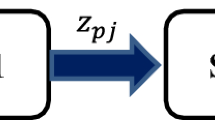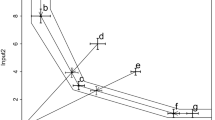Abstract
A three stage approach is proposed to measure technical efficiency in a fuzzy environment. This approach uses the traditional data envelopment analysis framework and then merges concepts developed in fuzzy parametric programming (Carlsson and Korhonen, 1986). In the first stage, vague input and output variables are expressed in terms of their risk-free and impossible bounds and a membership function. This membership function represents the degree to which a production scenario is plausible. In the second stage, conventional efficiency measurement models (Banker, Charnes and Cooper, 1984; Deprins, Simar and Tulkens, 1984) are re-formulated in terms of the risk-free and impossible bounds and the membership function for each of the fuzzy input and output variables. In the third stage, technical efficiency scores are computed for different values of the membership function so as to identify uniquely sensitive decision making units. The approach is illustrated in the context of a preprint and packaging manufacturing line which inserts commercial pamphlets into newspapers.
Similar content being viewed by others
References
Almond, R.G. (1995). “Discussion: Fuzzy Logic: Better Science Or Better Engineering?” Technometrics 37:3, 267–270.
Athanassopoulos, A., and K. Triantis. (1998). “Assessing Aggregate Cost Efficiency and the Related Policy Implications for Greek Local Municipalities.” Forthcoming.
Banker, R. D., A. Charnes, and W. W. Cooper. (1984). “Some Models for Estimating Technical and Scale Efficiencies in Data Envelopment Analysis.” Management Science 30:9, 1078–1092.
Bazaraa, M. S., J. J. Jarvis, and H. D. Sherali. (1990). Linear Programming and Network Flows. New York: John Wiley & Sons.
Bellman, R. E., and L. A. Zadeh. (1970). “Decision Making in a Fuzzy Environment.” Management Science 17:4, 141–164.
Bonaplata, J. (1995). “Evaluation of Productivity and Quality Performance in the Newspaper Preprint Insertion Process.” Masters project and report, Virginia Tech, Department of Industrial and Systems Engineering, Blacksburg, Virginia.
Carlsson, C., and P. Korhonen. (1986). “A Parametric Approach To Fuzzy Linear Programming.” Fuzzy Sets and Systems 20, 17–30.
Charnes, A., W. W. Cooper, and E. Rhodes. (1978). “Measuring the Efficiency of Decision Making Units.” European Journal of Operational Research 2, 429–444.
Cooper, W. W., K. K. Sinha, and R. S. Sullivan. (1992). “Measuring Complexity in High-Technology Manufacturing: Indexes for Evaluation.” Interfaces 4:22, 38–48.
Deprins, D., L. Simar, and H. Tulkens. (1984). “Measuring Labor Efficiency on Post Offices.” In Marchand, Pestieau, and Tulkens (eds.), The Performance of Public Enterprises: Concepts and Measurement. Amsterdam: North Holland, 243–267.
Färe, R., S. Grosskopf, and C. A. K. Lovell. (1994). Production Frontiers. Cambridge: Cambridge University Press.
Fried, H. O., C. A. K. Lovell, and S. S. Schmidt (eds.). (1993). The Measurement of Productive Efficiency: Techniques and Applications. New York: Oxford University Press.
Girod, O. A. (1996). “Measuring Technical Efficiency in a Fuzzy Environment,” Doctoral (Ph.D.) dissertation, Virginia Tech, Department of Industrial and Systems Engineering, Blacksburg, Virginia.
Girod, O. A., and K. Triantis. (1998). “The Evaluation of Productive Efficiency Using a Fuzzy Mathematical Programming Approach: The Case of the Newspaper Preprint Insertion Process.” Forthcoming. IEEE Transactions on Engineering Management.
Kosko, B. (1993). Fuzzy Thinking: The New Science of Fuzzy Logic. New York: Hyperion Publisher.
Land, C. A. K. Lovell, and Thore. (1993). “Chance-Constrained Efficiency Analysis.” Managerial and Decision Economics 14, 541–553.
Seaver, B. L., and K. P. Triantis. (1992). “A Fuzzy Clustering Approach Used in Evaluating Technical Efficiency Measures in Manufacturing.” Journal of Productivity Analysis 3, 337–364.
Sengupta, J. K. (1987). “Data Envelopment Analysis for Efficiency Measurement in the Stochastic Case.” Computers in Operational Research 14:2, 117–129.
Sengupta, J. K. (1992). “A Fuzzy Systems Approach in Data Envelopment Analysis.” Computers Math. Applic. 24:8/9, 259–266.
Tulkens H. (1993). “On FDH Efficiency Analysis: Some Methodological Issues and Applications to Retail Banking, Courts, and Urban Transit.” The Journal of Productivity Analysis 4, 183–210.
Triantis, K. and R. McNelis. (1995). “The Measurement and Empirical Evaluation of Quality and Productivity for a Manufacturing Process: A Data Envelopment Analysis (DEA) Approach.” In R. Schraft, W. Sullivan, M. Ahmad, and H. Jacobi (eds.), Flexible Automation and Intelligent Manufacturing. New York: Begell House, 1134–1145.
Zadeh, L. A. (1965). “Fuzzy Sets.” Information and Control 8, 338–353.
Zimmermann, H. J. (1986). Fuzzy Set Theory and Mathematical Programming, Fuzzy Set Theory and Applications. Riedel Publishing Company.
Zimmermann, H. J. (1991). Fuzzy Set Theory and Its Applications, Second Edition. Boston: Kluwer Academic Publishers.
Author information
Authors and Affiliations
Rights and permissions
About this article
Cite this article
Triantis, K., Girod, O. A Mathematical Programming Approach for Measuring Technical Efficiency in a Fuzzy Environment. Journal of Productivity Analysis 10, 85–102 (1998). https://doi.org/10.1023/A:1018350516517
Issue Date:
DOI: https://doi.org/10.1023/A:1018350516517




